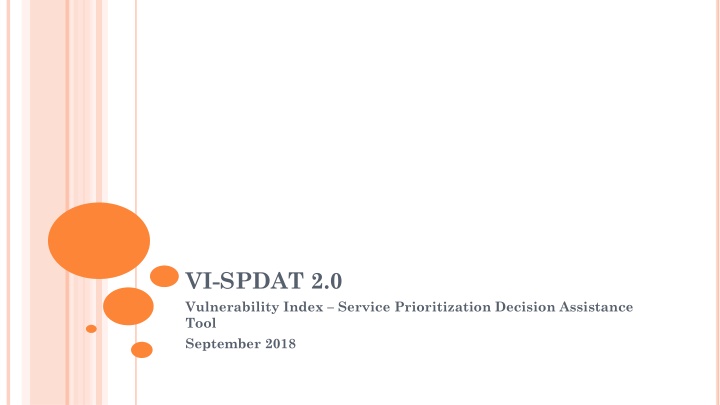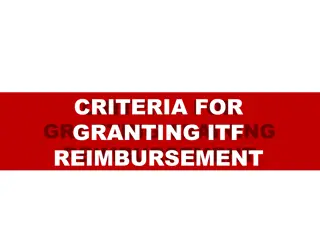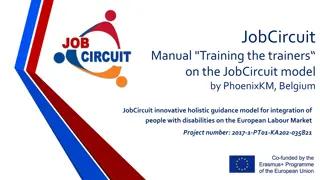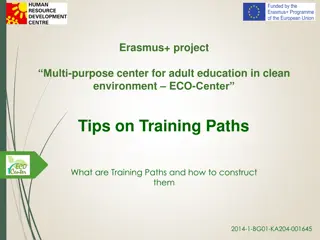
VI-SPDAT 2.0: Tool for Prioritizing Homeless Community Support
VI-SPDAT 2.0 is a powerful tool combining Vulnerability Index (VI) and Service Prioritization Decision Assistance Tool (SPDAT) to pre-screen homeless individuals quickly and efficiently. It helps match people with appropriate support and housing interventions, prioritizing based on their needs and acuity level within the community.
Download Presentation

Please find below an Image/Link to download the presentation.
The content on the website is provided AS IS for your information and personal use only. It may not be sold, licensed, or shared on other websites without obtaining consent from the author. If you encounter any issues during the download, it is possible that the publisher has removed the file from their server.
You are allowed to download the files provided on this website for personal or commercial use, subject to the condition that they are used lawfully. All files are the property of their respective owners.
The content on the website is provided AS IS for your information and personal use only. It may not be sold, licensed, or shared on other websites without obtaining consent from the author.
E N D
Presentation Transcript
VI-SPDAT 2.0 Vulnerability Index Service Prioritization Decision Assistance Tool September 2018
WHAT IS THE VI-SPDAT? VI-SPDAT is the combination of Two tools Vulnerability Index (VI) & Service Prioritization Decision Assistance Tool (SPDAT) Pre-screening or triage tool A Survey Designed to be used by all providers within a the CoC Quickly assesses the health and social needs of homeless persons Usually takes less than 7 minutes to complete Matches people with the most appropriate support and housing interventions that are available in the community
WHAT IS THE VI-SPDAT? Allows homeless service providers to similarly assess and prioritize the the homeless community and identify whom to treat first based on the acuity of their needs Service providers, outreach workers can use it The scores can then be compared and used to identify and prioritize candidates for different housing interventions based upon their acuity Instead of only assisting those who present at your particular agency, we work together to prioritize all homeless people in the community, regardless of where they are assessed Prioritizes households in a consistent and transparent manner No cherry picking and back door entry.
WHAT IS THE VI-SPDAT? The VI-SPDAT and SPDAT are different VI-SPDAT is a triage tool (also referred to as a pre-screen tool) The VI-SPDAT measures the Presence of an issue, NOT the depth of the issue SPDAT is an assessment tool The SPDAT digs deeper into the context, history, environment and severity of an issue in a more nuanced manner than the VI-SPDAT
WHAT THE VI-SPDAT IS NOT NOT an assessment tool (The SPDAT is!) NOT a diagnostic tool NOT the VI or the SPDAT
IS THERE FLEXIBILITY IN THE WORDING & CONTENT? Developed by Community Solutions and OrgCode Consulting, Inc Each word and phrase within the tool has been carefully and rigorously tested Not allowed to make any changes in wording, content, or order of the questions They spent a lot of money in testing this tool. (VI-SPDAT is the only tool built from experience of people that are homeless through those in Academic levels)
GATHERING THE INFORMATION The VI-SPDAT is designed and structured to only use self-report The person who is being surveyed using the VI-SPDAT should be able to complete it with anyone, not just the people who know her/his case history or have other information from other circumstances or sources The order of the VI-SPDAT cannot change.
CONSENT An individual must provide informed consent prior to the VI- SPDAT being completed. You cannot complete a VI-SPDAT with a client without that person s knowledge and explicit agreement. You also cannot complete the VI-SPDAT solely through observation or using known information within your organization Even when you know an answer is wrong , you can not correct it. You can only attempt to clarify the question then re-read the question as written..
WHEN Outreach: At time of engagement (not always first meeting) Shelter: Shelter workers are encouraged to develop a housing plan with clients and assess whether or not the clients would need a VI-SPDAT completed.
WHICH VI-SPDAT? Two Adult Household: Recommended for both adults to complete the singles survey (VI- SPDAT v2.0). Adult Parent (s) with Adult Child(rent) 18-24: Adult parent should complete the singles survey (VI-SPDAT v2.0) If the household includes multiple children (minors and/or adult children) use the family survey if the household includes minors. Parent with youth: Complete the family survey (VI-FSPDAT v2.0). Pregnant Single Adult: Single survey and encourage the participant to report the change after the birth of the child Youth 24 or under: unaccompanied youth - TAY-VI-SPDAT v1.0
WHO GETS A VI-SPDAT COMPLETED Not every clients you meet!! Only clients that meet HUD s definition of HUD Definition of homelessness should complete a VISPDAT.
APPROACH TO THE VI-SPDAT Safety First Privacy Distraction Free Environment Positive & Hopeful Realistic and Affirming Open Body Language Administered using Trauma Informed Care
TRAUMA INFORMED CARE Definition of Trauma The experience of violence and victimization including sexual abuse, physical abuse, severe neglect, loss, domestic violence and/or witnessing domestic violence, terrorism, or disasters. Responses to Trauma include intense fear, horror, and helplessness. Clients may be agitated or aggressive. Clients may be withdrawn or guarded. It is fair to assume that people experiencing homelessness are, in fact, experiencing trauma. WE don t get to define what is traumatic for our clients; they do.
TRAUMA INFORMED CARE + VI-SPDAT Basic Customer Service We do no harm Assume every client has been exposed to abuse, violence, neglect, or other traumatic experiences Focus on what happened to you and not what s wrong with you Take some time to unpack the client s suitcase
INTRODUCTORY SCRIPT Everyone in the CoC must use the same introductory script Explains how we are using the VI-SPDAT, How the information is stored, and What happens with the information collected from the VI-SPDAT Using the same introductory script, regardless of agency or affiliate, assures that the assessment is given the same way, every time
THE VI-SPDAT DOS AND DONTS Dos Dont s Complete a survey without informed consent of the client. Complete the survey by observation. Tell people there is a score (number) or refer to them as a number. Try to serve or case manage while doing the survey. Promise anything as a result of the survey. Lead people to believe there is a waiting list. Change wording or scoring. Change the order of questions. Explain what the survey does. Encourage people to be honest. Provide clarification when/if requested. Ensure the client has completed a Release of Information (ROI) prior to completing the VISPDAT.
1st Put ROI!! WHERE ON HMIS 2nd: - Go to Assessment Tab
3rd: Click on This - Then fill everything out on this slide
DOMAINS History of Housing Risks Socialization & Daily Functions Wellness Family Unit (VI-F-SPDAT only)
VI-SPDAT COMPONENTS History of Housing History of Housing and Homelessness Risks Risk of Harm to Self or Others Involvement in High-Risk and/or Exploitive Situations Interactions with Emergency Services Legal Issues Managing Tenancy Socialization and Daily Functions Self-Care and Daily Living Skills Personal Administration and Money Management Meaningful Daily Activities Social Relations and Networks Wellness Mental Health and Wellness and Cognitive Functioning Physical Health and Wellness Medication Substance Use Experience of Abuse and/or Trauma Family Unit Size of Family Interaction with Child Protective Services and/or Family Court Needs of Children Stability and Resiliency of the Family Unit Parental Engagement
TYPES OF QUESTIONS Pre-screen tool that is used to triage clients across the entire homeless population, All VI-SPDAT questions result in Yes , No , Refused , or one- word answers. How the questions are structured is important, as is the ordering of the questions Linked Questions are sets of two or more questions that together help determine a single scoring point A Stand-Alone Question is when just one question is asked to determine a scoring point. Every question must be asked, and a response must be recorded for every question
TYPES OF QUESTIONS Every question must be asked, and a response must be recorded for every question Even if that response is Refused. Even if you know that a person meets all of the criteria to get a point for the question set once they have answered the first question If a person refuses to answer one of the questions in a Linked Question set, mark Refused and keep asking the other questions in the set It may still be possible to assign a score to the Linked Question set A Linked Question set is only unusable if ALL of the questions that are linked together are Refused . Remember: There is absolutely nothing arbitrary about why the VI-SPDAT asks the questions that it does in the manner that it does.
ADMINISTRATIVE INFORMATION VI-SPDAT v2.0 US (Page 1) Administration interviewer s name, the agency conducting the interview the interviewer s role survey date, time, location.
VI-SPDAT v2.0 Family (Page 1) Basic Information US BASIC INFORMATION
BASIC INFORMATION Children (VI-F-SPDAT only) Increase the number of bedrooms required Record the number of children that currently live with the family Number of children expected to move in with the family after housing This question is assessing whether the household is actively looking for housing that would support those children as well If there is a female in the household, also ask if anyone in the family is currently pregnant Asked if there is a female present (or anyone who identifies as female), Regardless of the age of the female It helps to reduce surveyor bias if every household that includes a female is asked this question, even if it is unlikely that they are not of an age where pregnancy is likely.
CURRENT SLEEPING ARRANGEMENT Question 1: Where do you sleep most frequently? (check one) Assess risk Establishes a baseline Directly related to a person s history of housing and homelessness Staying with friends or family is considered higher risk o Couch surfing falls under other . The VI-SPDAT is not asking about the HUD definition of homeless. The VI-SPDAT is measuring vulnerability. Couch surfing is considered highly dangerous because we do not know the circumstances of that living arrangement. OR SAFE HAVEN, score 1 point. SHELTER, TRANSITIONAL HOUSING, If the client answers anything other than
CURRENT SLEEPING ARRANGEMENT Question 2: How long has it been since you lived in permanent stable housing? Permanent housing is housing that is not temporary (i.e. halfway house, Transitional Housing) No time limit imposed on the person living there Stable housing is housing that is reliable and that the person can return to every day without fear of being locked out, or having to move frequently. 4+ episodes of homelessness, score 1 point. consecutive years of homelessness, and/or If the client has experienced 1 or more
CURRENT SLEEPING ARRANGEMENT Question 3: In the last three years, how many times have you been homeless? This includes any and all types of homelessness (include living in a car, transitional housing stays, doubled up, couch surfing, living outdoors, staying in shelters, etc.) Also includes homelessness during periods of incarceration or during hospital stays. Does NOT include adult children living with parents. Question 3 can be modified. Instead of saying In the past three years you may replace it with Since [insert date and year equal to three years ago] how many times have you been homeless? 4+ episodes of homelessness, score 1 point. consecutive years of homelessness, and/or If the client has experienced 1 or more
EMERGENCY SERVICE USE Question 4 In the past six months, how many times have you Examines the frequency of the respondent s interaction with various emergency services. To increase accuracy, you should assist the client s recall by putting the past 6 months in context. Count back six months out loud Include a landmark date when appropriate (Since the 4thof July, how many times have you. . .) equals 4 or more, score 1 point. If the TOTAL NUMBER of interactions
EMERGENCY SERVICE USE Question 4 In the past six months, how many times have you a) Received health care at an emergency department/room? looking for the number of times an individual has engaged with emergency resources for the purposes of health care Does not include times when an individual goes to the emergency department for purposes other than health care (for example, to warm up on a cold night but does not engage with health care; b) Taken an ambulance to the hospital? c) Been hospitalized as an inpatient? d) Used a crisis service, including rape crisis, mental health crisis, domestic violence, distress centers and suicide prevention hotlines? equals 4 or more, score 1 point. If the TOTAL NUMBER of interactions
EMERGENCY SERVICE USE Question 4 In the past six months, how many times have you e) Talked to police because you witnessed a crime, were the victim of a crime, or the alleged perpetrator of a crime or because the police told you that you must move along? Interaction is for the purposes of law enforcement f) Stayed one or more nights in a holding cell, jail or prison, whether that was a short-term stay like the drunk tank, a longer stay for a more serious offence, or anything in between? equals 4 or more, score 1 point. If the TOTAL NUMBER of interactions
RISK OF HARM Question 5: Have you been attacked or beaten up since you ve become homeless? Covers the entire time they have been homeless, including every instance of homelessness in their lifetime Question 6: Have you threatened to or tried to harm yourself or anyone else in the last year? The person does not need to have been homeless at the time of these threats or attempts. Includes threats in person, on the phone, on social media or another person in the last 12 months. question, score 1 point. If the client answers YES to either
LEGAL ISSUES Question 7: Do you have any legal stuff going on right now that may result in you being locked up, having to pay fines, or that make it more difficult to rent a place? Legal Stuff - Includes any type of legal matter such as being on a registered offender list, outstanding warrants, moving violations, pending charges, etc. It must be an issue that can result in either being incarcerated or having to pay a fine for an offence If the client answers yes , score 1 point.
EXPLOITATION Question 8: Does anybody force or trick you to do things that you do not want to do? The use of force may be through physical or emotional means. Question 9: Do you ever do things that may be considered to be risky like exchange sex for money, run drugs for someone, have unprotected sex with someone you don t really know, share a needle, or anything like that? Not seeking specifics politely interrupt and let them know that you are seeking to know if they do any of these types of things, not which specific thing or the context in which that occurred If YES to either question, score 1 point.
MONEY MANAGEMENT Question 10: Is there any person, past landlord, business, bookie, dealer, or government group like the IRS that thinks you owe them money? This question should not be confused with asking whether the person owes anybody money Question 11: Do you get any money from the government, a pension, an inheritance, working under the table, or a regular job, or anything like that? Put the emphasis on how you ask or anything like that? so as to be clear that you are not looking for specifics of how they get money 11, score 1 point. If yes to question 10, or no to question
MEANINGFUL DAILY ACTIVITY Question 12: Do you have planned activities other than just surviving that make you feel happy and fulfilled? Activities that they choose Provide personal satisfaction A sense of intellectual, emotional, social, physical or spiritual fulfilment If the answer is no , score 1 point.
SELF CARE Question 13: Are you able to take care of basic needs like bathing, changing clothes, using a restroom, getting food and clean water and other things like that? Does the individual have both access to and the ability to take care of basic needs, including personal hygiene Remember that this is self-report Even if the person appears as if they have not bathed, if they say Yes, that is what you mark If the answer is no , score 1 point.
















